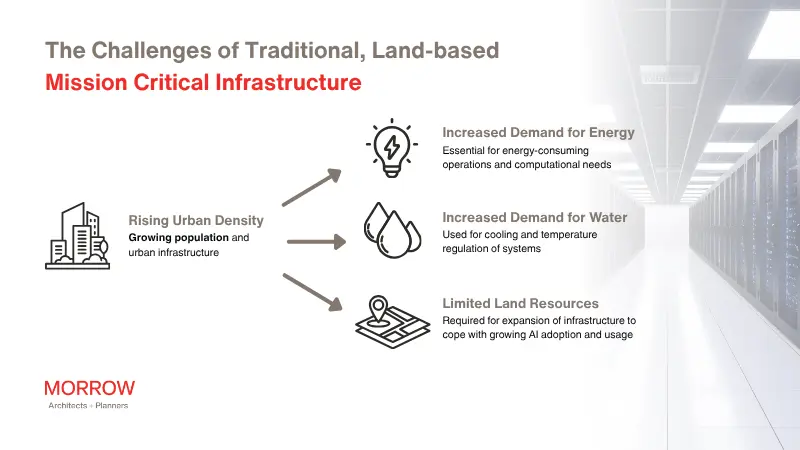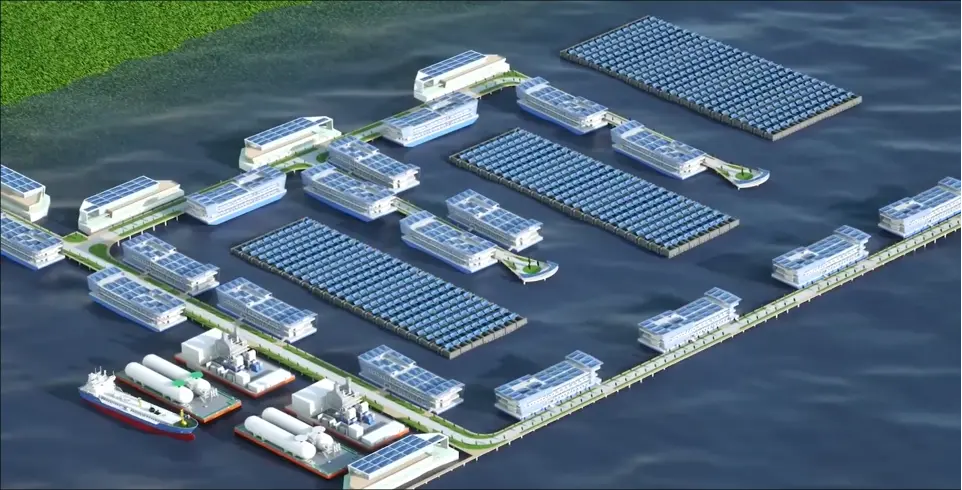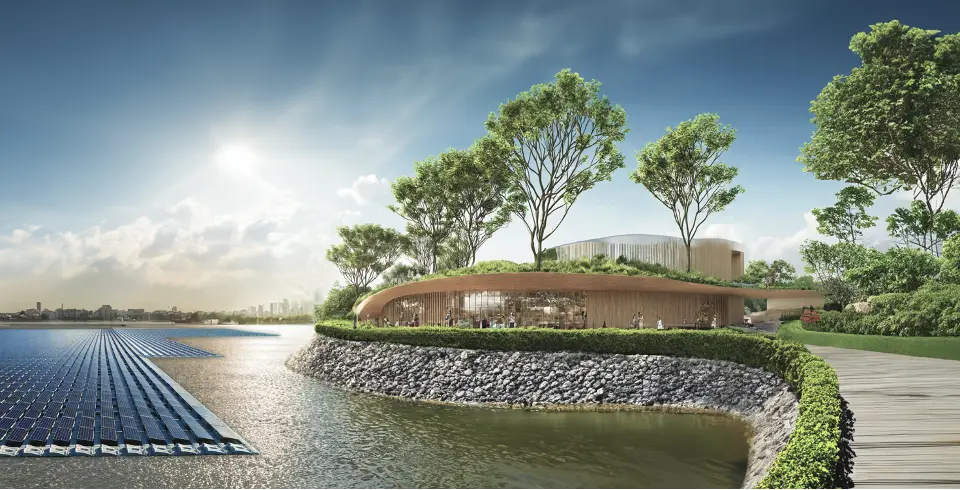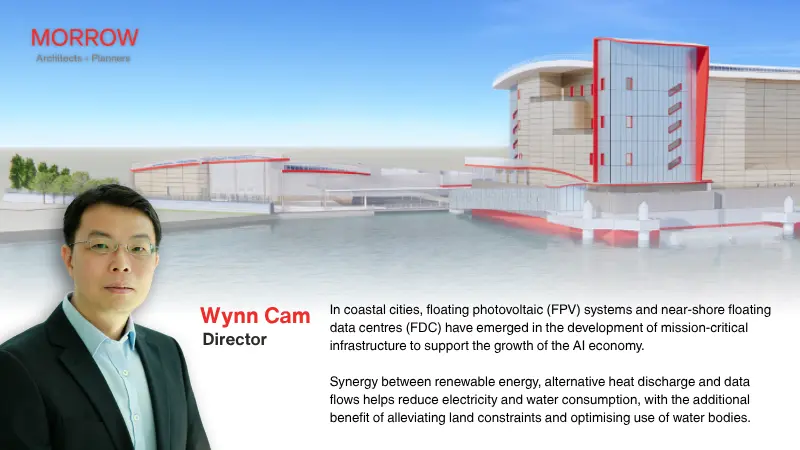As artificial intelligence reshapes the global economy, the demand for reliable, sustainable, and scalable mission-critical infrastructure continues to surge. Traditional land-based facilities face competing demands for resources such as space, energy and water, especially in resource-scared island cities like Singapore. In such coastal cities, Floating Photovoltaic (FPV) systems and near-shore floating data centres (FDC) have emerged as alternative development typologies to support the growth of the AI economy. Creating a synergy between data flows, renewable energy, alternative heat discharge, they substantially reduce electricity and water consumption, with the additional benefit of alleviating land constraints and optimising use of water bodies. These advancements illustrate how our natural elements and systems can be repositioned to form new kinds of connectivities that power the next generation of intelligent industries.
The Rise of the AI Economy
Artificial Intelligence is no longer a peripheral technology, but the defining force of the current and future digital landscape. From generative models transforming creative industries to deep-learning algorithms that optimise logistics, healthcare and finance operations, the list grows day-by-day. AI’s reach continues to expand exponentially, yet this transformation depends on a lesser-seen foundation: mission-critical infrastructure capable of sustaining the vast computational power required.
As AI adoption rates and workloads balloon, so does the intensity of energy consumption for data processing. The world’s data centres consume an estimated 2-3% of global electricity today, and in time this number will further increase. These facilities require not just constant power but also stable cooling systems and near-perfect uptime. However, traditional, land-based mission-critical infrastructure is struggling to meet these demands amid rising urban density, which also further escalates energy and water demands.

This tension between digital growth and environmental responsibility has led policymakers, infrastructure providers, operators, architects, and engineers to explore an alternative frontier – floating and energy-efficient systems capable of supporting high-performance computing and large volumes of data flow, backed by renewable energy sources. These next-generation infrastructures are not simply extensions of the cloud, but demand for a new level of symbiotic ecosystems — where data flows through networks powered by the elements themselves.
Mission-Critical Infrastructure in the Age of AI
Mission-critical infrastructure, encompassing data centres, network structures, and to an extent, renewable energy systems, has evolved from a back-end utility to a strategic pillar of economic dominance.
In the AI era, performance metrics go beyond uptime. Systems must deliver:
- Ultra-low latency to support real-time machine learning
- Scalable modularity to remain adaptable to fluctuating data demands
- Sustainability to align with global decarbonisation goals
- Climate resilience to ensure reliability in volatile environments
AI-driven workloads, particularly for deep learning and generative intelligence, require dense clusters of GPUs and accelerators, each producing substantial heat and power demand. Traditional data centres often rely on air-cooled systems, consuming immense volumes of energy and water, while the finite availability of suitable land resources and grid capacity limits options for expansion.
The next generation of facilities must therefore be adaptive and modular for speedy scaling and deployment, while drawing power from clean and renewable energy sources. This has sparked inspiration for nearshore floating infrastructures that can combine renewable energy generation – via solar, wind and tidal – with high-efficiency, water-based cooling system.

(Image credit: MORROW and Keppel Data Centres)
Floating Data Centres: Reimagining the Built Environment
The concept of floating infrastructures has evolved rapidly, from futuristic speculations into viable development. Floating data centres – modular and scalable architecture – harness the natural thermal properties of seawater to improve cooling efficiency and reduce carbon intensity.
Coastal and inland waters represent underutilised domains, with the potential to support energy-efficiency and sustainable energy generation. By situating computational nodes near shore, developers can expand capacity without competing for land or adding heat stress to urban microclimates.
The floating data centre employs seawater-based cooling loop that can reduce energy consumption for data hall cooling. The hull structure acting as buoyant foundation adapt naturally to changing tidal levels – a key advantage in an era of rising seas and extreme weather.
The design ethos behind the floating data centre was inspired from the succinctly and aptly phrased concept, “Sun and Sea for Data Connectivity”. This concept channels natural forces into integral components of the digital infrastructure, with the Sun providing a source of renewable power through solar photovoltaic integration, and the Sea acting as a natural coolant, providing a consistent and readily-available solution for thermal regulation.


(Image credit: MORROW and Keppel Data Centres)

(Image credit: MORROW and Keppel Data Centres
Floating Photovoltaic (FPV) systems: Transforming Water Surfaces into Energy Fields
Floating Photovoltaic (FPV) systems, which are solar arrays deployed on lakes, reservoirs, and calm coastal waters, have become an essential element of the blue-green energy transition. They combine the proven efficiency of solar technology with the cooling advantage of water, increasing energy yield compared to land-based systems. In addition to the production of clean electricity, they also reduce water evaporation in reservoirs, and utilise the otherwise idle surfaces.
Design Integration and Environmental Stewardship
Successful FPV developments adopt a holistic design framework that balances energy performance with ecological sensitivity. A representative concept, SOLACE – short for Solar Active Landscape and Community Environment – illustrates this approach
The design envisions a series of interconnected floating solar panels surrounded by landscaped waterfronts, educational trails, and operational hubs. The objective is to blend infrastructure, ecology, and community into one harmonious landscape.
Architectural renderings of such projects provide the blueprint for buildings constructed with soft, organic forms and natural materials, while being able to sustain light-footprint operations. These structures, capable of housing essential control rooms, meteorological stations, and a viewing deck for visitors, demonstrate how infrastructure can engage, educate, and inspire, while delivering high-performance energy outcomes that set a new benchmark for environmentally sustainable infrastructure.

(Image credit: MORROW Architects & Planners)
Synergy Across the Ecosystem
When floating PV systems are integrated with floating data centres or industrial clusters, they can create a synergistic ecosystem of energy generation and consumption, or an intelligent water-based grid supporting the AI economy. The convergence of floating data centres with renewable water-based systems signals a paradigm shift: the inception of an interconnected, adaptive infrastructure ecosystem where the natural elements and data function as one continuous network. This synthesis not only underpins the future of the AI economy, but also demonstrates a new design language, where the infrastructure of our intelligence mirrors the resilience of natural systems.
As global industries race to scale AI capabilities, the infrastructure challenge is as much ecological as it is technological. The next frontier of innovation lies in designing systems that are uptime, fluid, modular, and regenerative, being capable of adapting to the physical, natural and social environments while sustaining continuous digital growth.

Toward a Symbiotic Intelligence
The transformation of mission-critical infrastructure is more than an engineering pursuit, but also an architectural, social and environmental endeavour. Floating data facilities and FPV systems show a pathway towards symbiotic intelligence, where technological progress must be sensitive to our planetary systems.
By reimagining infrastructure as a living interface, one that draws strength from the elements and gives back through efficiency and resilience, we can lay the foundations for an AI economy that is both powerful and sustainable.
In this vision, AI infrastructure is no longer confined to fibre optics or man-made network infrastructure. It extends to the Sun that powers computation, the Sea that cools it, and the Data that are inter-connected for human development. The future of intelligence, therefore, is not merely artificial; it is profoundly interconnected man, data, and nature.

With nearly 20 years of practice in Sydney and Singapore, Dr Cam has established himself as a seasoned professional in the field of sustainable architecture and urban design. His expertise encompasses a diverse array of project types and scales – from city planning and township development to innovation districts, university campuses, mixed-use complexes, housing precincts, and individual buildings. This breadth of experience reflects his versatility and depth of knowledge.
Among his notable projects are ESSEC Business School, Jurong Innovation District Master Plan, Guangzhou Knowledge City, Saigon Sports City, High-rise Green Data Centre, and multi-storey Floating Data Centre in Singapore.


